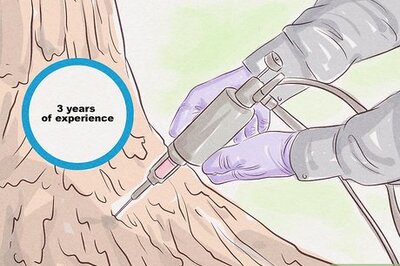
views
Guwahati: Four poachers were killed in a gunfight with wildlife rangers at the famed Kaziranga National Park in Assam on Friday, three days after seven poachers were arrested on the fringe of the sanctuary, officials said.
A wildlife warden said a group of six poachers entered the park early on Friday and fired at an adult rhino near the Mihimukh range, although they failed to hit the target.
"A six-member team of forest guards upon hearing the gunshots gave the poachers a chase and soon there was a gunfight between the two sides," park warden D. Gogoi told IANS.
The encounter continued for about 30 minutes in which four poachers were killed, while two more managed to escape taking cover of the thick undergrowths.
"A massive hunt is on with forest guards riding on elephant backs on the trail of the two poachers," the warden said.
A rifle along with a large quantity of ammunition, jungle boots, food stuff, and raincoats, were recovered from the dead poachers.
"We believe the two poachers who escaped might have fled with the weapons carried by their colleagues," the warden said.
This is the second major success by forest rangers this week. On Tuesday, seven poachers were arrested while they were coming in a car to sell a rhino horn to an international animal organ smuggling syndicate close to the park.
A rhino horn and cash amounting to Rs.345,000 were seized from the gang Tuesday.
"We are happy with the way our forest guards are fighting an organised poaching syndicate active in the park area. We cannot ignore the help from local villagers living on the periphery of the park in our fight against poachers," Assam Forest Minister Rockybul Hussain told IANS.
"Along with forest guards, we are also taking the help of the Border Security Force, the army and local villagers to combat poachers," the minister said.
The 430 sq km park is home to the world's largest concentration of one-horned rhinoceros. As per the 2009 census report, some 2,048 of the world's estimated 3,000 one-horned rhinos lumber around the swamps and grasslands of Kaziranga, their concentration here ironically making the giant mammals a favourite target of poachers.
Nine of the beasts were killed so far this year, while 18 rhinos were killed in 2008 and 14 in 2009.
Between 1980 and 1997, some 550 rhinos were killed by poachers in the wilds of Kaziranga, the highest being 48 in 1992.
Poachers kill rhinos for their horns, which many believe contain aphrodisiac qualities, besides being used as medicines for curing fever, stomach ailments and other diseases in parts of Asia.
Rhino horns are also much fancied by buyers from the Middle East who turn them into handles of ornamental daggers, while elephant ivory tusks are primarily used for making ornaments and decorative items.
Profits in the illegal rhino horn trade are staggering, A rhino horn sells for up to Rs.1.5 million per kilogram in the international market after the horns are smuggled to clandestine Asian markets, according to officials of the forest department.
Once extracted, the rhino horn is routed to agents in places like Dimapur in Nagaland, Imphal in Manipur and Siliguri in West Bengal.
A possible route of rhino horn smuggling is to Kathmandu via Siliguri and then from Nepal to China and the Middle East. The other possible route is from Imphal to Moreh on the Manipur border with Myanmar and then via Myanmar to Thailand, Vietnam, Singapore and China.




















Comments
0 comment